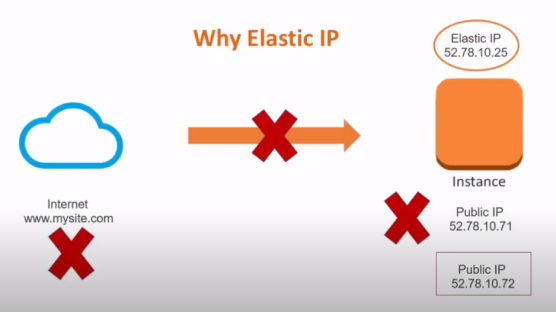Question 361 of 375 from exam CLF-C01: AWS Certified Cloud Practitioner
Question
Which of the following statements related to the AWS Global Infrastructure are correct? Select best TWO.
Answers
Explanations
Click on the arrows to vote for the correct answer
A. B. C. D. E.Answers: C and D.
Option A is incorrect because the first level of redundancy is always Availability Zones when it comes to High Availability & Performance.
When applications are deployed across multiple Availability Zones within the same region, a single Availability Zone's failure will not result in the application being unavailable as the failover mechanism will switch the request of a client to another availability zone.
When requests are routed through a load-balancer, it will manage requests depending on the resource utilization of services within an availability zone.
This will ensure the good performance of the application.
Regional replications are a second level of redundancy where data is replicated between Geographical Regions.
One of the reasons could be a Disaster Planning architecture for Business Continuity where a complete Region becomes unavailable & a backup of the data can be maintained in another region for redundancy.
Option B is incorrect.
Edge locations are used by services like CloudFront to cache data & reduce latency for end-user access by using those Edge locations as a Global Content Delivery Network (CDN)
EC2 instances can be used as Origin servers to a CloudFront distribution for serving dynamic content.
Option C is CORRECT.
An Availability Zone is a logical Data Center within a Region.
Each zone in a Region has redundant and separate power, networking and connectivity to reduce the likelihood of two zones failing simultaneously.
Each zone could be backed with one or more physical Data Centers, the largest being backed by 5.
Option D is CORRECT.
Copying an AMI from one region to another enables you to launch consistent instances based on the same AMI to different Regions.
The consistency can be observed from the fact that the AMI's can contain pre-installed software that can be used in different regions.
For example, if I have a redundant AMI copy as a backup in another Region, it becomes easy to launch an EC2 instance from that AMI in that Region without re-installing all those software again, thus improving downtime of my applications.
Option E is incorrect.
Elastic IP (EIP) addresses are static IP addresses that can be created and assigned within an AWS Account rather than an Availability Zone.
You can have a maximum of 5 EIP's for an Account.
It can be assigned to an EC2 instance.
An EIP is most useful for an application hosted on a single EC2 instance with its IP mapped to a domain name.
When the EC2 instance has a public IP & getting restarted, it will be assigned a new public IP making the site unavailable unless it is remapped to the domain.
An EIP will help here by retaining the same public IP address at the time of a server restart so that the site does not incur downtime.
Diagrams:
References:
https://aws.amazon.com/about-aws/global-infrastructure/?p=ngi&loc=0 https://digitalcloud.training/certification-training/aws-certified-cloud-practitioner/aws-global-infrastructure/ https://aws.amazon.com/blogs/aws/ec2-ami-copy-between-regions/ https://www.rackspace.com/blog/aws-101-regions-availability-zones#:~:text=An%20availability%20zone%20is%20a,use%20by%20any%20AWS%20customer.&text=In%20each%20zone%2C%20participating%20data,over%20redundant%20private%20network%20links.
The correct statements related to the AWS Global Infrastructure are:
A. For achieving High Availability and Performance, customers usually deploy their applications across multiple AWS Regions C. Availability zones can contain one or more data centers
Explanation:
AWS Global Infrastructure is a collection of physical data centers, availability zones, edge locations, and regions spread across the globe. Here are the explanations for each statement:
A. For achieving High Availability and Performance, customers usually deploy their applications across multiple AWS Regions:
AWS Regions are a physical location where AWS has multiple data centers in a specific geographic area. These data centers are isolated from each other to provide fault tolerance and high availability. By deploying applications across multiple regions, customers can achieve high availability and performance. This way, if there is an outage in one region, the application can still be accessed from another region.
C. Availability zones can contain one or more data centers:
An Availability Zone (AZ) is a distinct location within an AWS Region that is engineered to be isolated from failures in other Availability Zones. Each Availability Zone consists of one or more data centers, each with redundant power, networking, and connectivity. By deploying applications across multiple Availability Zones, customers can achieve high availability and fault tolerance.
B. Edge locations can be used to deploy infrastructures like EC2 instances, EBS storage:
Edge locations are endpoints for AWS services like Amazon CloudFront, Amazon Route 53, and AWS Shield. These locations are designed to cache and deliver content from Amazon S3 buckets or EC2 instances to end-users at low latency. They can be used to deploy infrastructures like EC2 instances, EBS storage, and other AWS services to improve performance.
D. An EC2 instance's AMI in a particular region can be copied to another region for using it in that Region:
An Amazon Machine Image (AMI) is a pre-configured virtual machine image used to create EC2 instances. An AMI can be copied from one region to another region to launch EC2 instances in a different region. This is useful when customers want to deploy their applications in different regions without having to create new AMIs.
E. An elastic IP address is allocated to an Availability Zone:
An Elastic IP address is a static, public IPv4 address that can be associated with an EC2 instance or a network interface. Elastic IP addresses are allocated to AWS accounts and can be remapped to any EC2 instance within the account's VPC. Elastic IP addresses are not allocated to an Availability Zone; they are allocated to the account and can be used in any Availability Zone in the same region.
